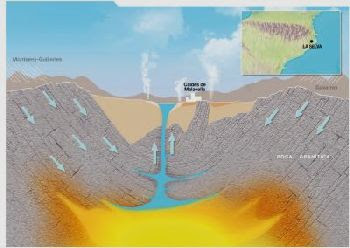
Monitoring the construction of wells, avoid over-exploiting cold groundwater close to hot groundwater, and controlling mineral water extraction. These are the recommendations from the Polytechnic University of Catalonia and the University of Barcelona, after analyzing the contamination of La Selva geothermal system, above all by arsenic pollution. In this region, which is known for its spa resorts and bottling plants, as well as in other Catalan coastal mountain ranges, uranium levels higher than what is recommended by the WHO have been detected.
The groundwater in La Selva (Girona, Spain) area show high levels of arsenic, antimony and other polluting elements. The area’s geothermal system, where hot and cold groundwater flow naturally, are the cause of this situation, according to a study that researchers from the Polytechnic University of Catalonia (UPC) and the University of Barcelona (UB) have published in the journal Geothermics.
“The system works by refilling meteoric waters that penetrate the earth in high areas, move underground and reach an unknown thermal hot spot, where they heat up and acquire CO2, and probably metals as well “Andrés Navarro, a lecturer at UPC and co-author of the project explained to SINC. “Afterwards the water leaches out (dissolve) the host rocks and flows out from the upwellings”.
In this process the waters naturally pick up pollutants. Consequently, the researchers have found high volumes of arsenic, silver, lead, antimony, zinc and other metals in the hydrothermal deposits, especially in the area of Caldes de Malavella (Girona), an area famous for its spa resorts and mineral water bottling companies.
The results show that groundwater in some areas has arsenic levels of up to 0.069 mg/l, when the legal limit in Spain and the rest of the European Union was 0.01 mg/l in water for human consumption.
“Fortunately, a few years ago a legislation for this was created, and since then bottled mineral has been controlled, although before then this did not occur” the researcher says. Furthermore, a plant to remove arsenic from public water supplies has been built in Caldes de Malavella.
In any case, the study recommends controlling the extraction of water for bottling plants, as well as over-exploiting cold groundwater close to hot water springs. This way the mixing of waters is avoided and so are the pollutants.
For the same reason it is not advisable to build wells close to geothermal upwellings, especially illegal ones for private supplies or irrigation. Studying geothermal liquid outlets in areas of diffused discharge, such as some humid areas, is also proposed.
“Making a model for managing the whole aquifer to rationalize water extraction and consumption would be the solution” Navarro says. He also highlights the need to take action regarding the natural water pollutants: uranium.
The analysis in La Selva shows “relatively high” levels (37.7 microg/l) of this element, especially in samples from sources and wells not directly linked to thermal activity.
The mobility of uranium is linked to granite rocks and is frequently found in Catalan coastal mountain ranges, where researchers have carried out specific studies on the topic. The samples have been taken from wells and drilling at a depth of up to 100 metres.
The results published in the journal Tecnología del agua and they show “significant concentrations” of uranium in groundwater used for public supply and bottling. Specifically, in some parts of the Montseny-Guilleries mountain range, these levels are more than 140 microg/l.
There are no legal limits for uranium concentrations in water in the European Union, but the analysis carried out in Catalan coastal mountain ranges shows that these levels far exceed the recommendations of the World Health Organisation (WHO), or for example, the standard established by the Environmental Protection Agency (EPA) in the USA.
Both the EPA and the WHO establish a maximum uranium level of 30 microg/l. The European Food Safety Authority (EFSA) is considering establishing a guideline level for this element, but at the moment the legal loophole remains.
The toxicity of uranium is linked to the solubility of the compound: the more soluble it is, the more toxic it is. The experiments carried out on animals and people show the most affected organ is the kidney, and alterations in reproduction and development are seen when this element exists in high concentrations.
Note: This story has been adapted from a news release issued by the FECYT – Spanish Foundation for Science and Technology









